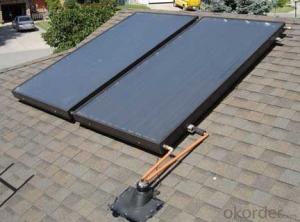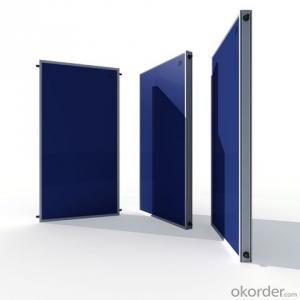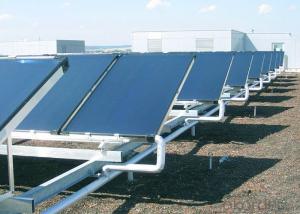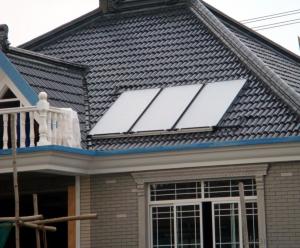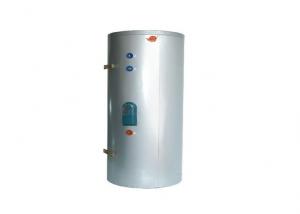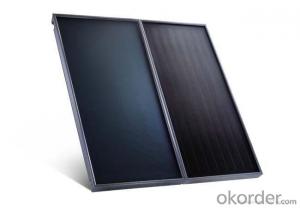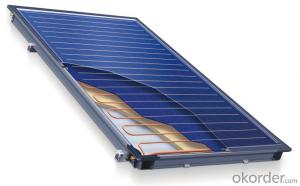Sunnyrain Heat Pipe solar collector,Solar Heat Pipe Vacuum Tube,solar thermal collector
- Loading Port:
- Shanghai
- Payment Terms:
- TT OR LC
- Min Order Qty:
- 500 pc
- Supply Capability:
- 10000 pc/month
OKorder Service Pledge
OKorder Financial Service
You Might Also Like
Brief Introduction of solar heat pipe
1) The products use super heat condition pipe and has a good effect of heat exchange.
2) The insulation layers use the up-to-date technology and has a good effect of temperature preservation which allows the water to stay warm for about 70 hours
3) Superior heat-preservation ensured by one-off molding polyurethane foam with thickness 50-60mm
4) Stable and reliable performance,well wind resistance
5) Meet the mankind healthy bath standard,the material of inner tank is SUS304-2Bstainless steel plate,the silica gel ring sealing has a long life against the erosion and it do no harm to health.
Main Advantages of solar heat pipe:
1.No scaling2.No blasting3.water-tight4.Anti aging5.low temperature-resistant6.high temperature-resistant 7.Resistant to high temperature8.fast heat transfer9.high heat conductivity10.bearing pressure
1)Highly efficient zbsorber of high performance with daily average effciency over 40%-50%
2)Start up quickly heat pipe transfer the heat energy into the storage tank in one condition
3)With stand pressure of 0.2Mpa,can be connected directly with city water pipe
4)Highly efficient insulation with polyurethane foam
5)Can be used all year round even in the cold weather
6)Automatically controlled
7)Highly heat absorber and less in heat losing
8)For both flat roof and slope roof

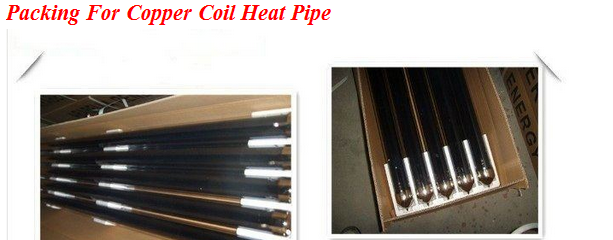
- Q:Can solar collectors be used in areas with limited access to information?
- Yes, solar collectors can be used in areas with limited access to information. Solar collectors are relatively simple and straightforward to install, operate, and maintain. Technical information and knowledge required for their use can be disseminated through on-site training, practical demonstrations, and simple user manuals. Additionally, local communities or organizations can provide support and guidance to ensure efficient and sustainable use of solar collectors in areas with limited access to information.
- Q:How do solar collectors impact cultural heritage sites?
- Solar collectors can have both positive and negative impacts on cultural heritage sites. On one hand, they can provide a sustainable and clean energy source, reducing the reliance on fossil fuels and minimizing the carbon footprint. This can contribute to the preservation and longevity of cultural heritage sites by reducing pollution and environmental degradation. However, the installation of solar collectors must be carefully planned and executed to avoid negatively affecting the visual integrity and historic value of these sites. In some cases, the placement of solar panels may obstruct or alter the original design and aesthetics of the heritage structures, compromising their authenticity and cultural significance. To mitigate potential negative impacts, it is crucial to involve heritage conservation experts and stakeholders in the decision-making process. This includes identifying appropriate locations for solar collectors, integrating them harmoniously into the site's surroundings, and ensuring their installation does not cause irreversible damage to the cultural heritage. By finding a balance between sustainability and preservation, solar collectors can contribute positively to cultural heritage sites.
- Q:How do solar collectors perform during winter months?
- Solar collectors can still perform well during winter months, although their efficiency may be slightly reduced compared to the summer months. The performance of solar collectors during winter is influenced by several factors. Firstly, the angle and orientation of the solar collectors play a significant role. In winter, the sun is lower in the sky and the days are shorter, so it is important to have the collectors at an optimal angle and facing south to maximize their exposure to sunlight. Adjusting the angle of the collectors can help capture more sunlight during the shorter winter days. Secondly, weather conditions can affect the performance of solar collectors. Cloudy or overcast days can reduce the amount of sunlight reaching the collectors, which in turn affects their efficiency. However, even on cloudy days, solar collectors can still generate some heat, albeit at a lower rate. Thirdly, the ambient temperature also impacts the performance of solar collectors. Cold temperatures can affect the heat transfer from the collectors to the heat transfer fluid or to the storage system. Insulation and proper design of the collectors and piping systems can help mitigate heat losses and maintain efficiency during winter. Lastly, the usage of a backup heating system can supplement the solar collectors during periods of low sunlight or extreme cold temperatures. This ensures a constant supply of heat even when solar energy is not sufficient. In conclusion, while the performance of solar collectors may be slightly reduced during winter months due to lower sunlight intensity and shorter days, they can still generate heat and contribute to the overall energy savings and sustainability of a building or system. Proper design, orientation, and maintenance can help maximize their efficiency even in colder climates.
- Q:Can solar collectors be used to generate electricity?
- Yes, solar collectors can be used to generate electricity. Solar collectors, such as photovoltaic panels, convert sunlight into direct current (DC) electricity through the photovoltaic effect. This DC electricity can then be converted into alternating current (AC) electricity using an inverter, making it suitable for powering various electrical devices and feeding into the grid.
- Q:Can solar collectors be used in greenhouses?
- Yes, solar collectors can be used in greenhouses. They can be installed on the roof or sides of the greenhouse to harness solar energy for heating, lighting, or powering ventilation systems. This helps in reducing the reliance on traditional energy sources and making greenhouses more sustainable and energy-efficient.
- Q:How do solar collectors compare to solar panels?
- Solar collectors and solar panels serve different purposes in harnessing solar energy. Solar collectors are primarily used for heating water or air, while solar panels are designed to convert sunlight into electricity. Solar collectors are more efficient in capturing and utilizing solar energy for heating purposes, as they are specifically designed for this function. On the other hand, solar panels are more commonly utilized for generating electricity, making them more suitable for powering homes or other electrical devices. Ultimately, the choice between solar collectors and solar panels depends on the intended use and energy requirements of the specific application.
- Q:Can solar collectors be used in energy storage facilities?
- No, solar collectors cannot be directly used in energy storage facilities. Solar collectors are used to capture solar energy and convert it into electricity or heat. Energy storage facilities, on the other hand, are used to store excess electricity generated from various sources, including solar power, for later use. While solar power can contribute to the energy stored in these facilities, it requires additional equipment such as batteries or pumped hydro systems to effectively store and release the energy.
- Q:What is the maintenance cost of a solar collector?
- The maintenance cost of a solar collector varies depending on factors such as the type of collector, size, location, and overall condition. However, in general, the maintenance cost of a solar collector is relatively low. Routine maintenance tasks may include cleaning the surface of the collector, checking for any leaks or damages, inspecting and cleaning the pipes or tubes, and ensuring proper functioning of the system. These tasks can typically be performed by the homeowner or a professional solar technician. Overall, the maintenance cost of a solar collector is considered to be minimal compared to the long-term energy and cost savings it provides.
- Q:Can solar collectors be used for heating prisons?
- Yes, solar collectors can definitely be used for heating prisons. Solar thermal systems can effectively capture sunlight and convert it into heat energy to provide heating for various applications, including prisons. This renewable energy source can help reduce the reliance on fossil fuels, lower energy costs, and promote sustainable practices in correctional facilities.
- Q:How does the orientation of a solar collector affect its performance?
- The orientation of a solar collector significantly affects its performance. The collector should be properly oriented to maximize solar energy absorption. Ideally, the collector should be facing towards the sun, with a tilt angle that corresponds to the latitude of the location. By optimizing the orientation, the collector can capture the maximum amount of solar radiation, thereby enhancing its efficiency and overall performance.
1. Manufacturer Overview |
|
|---|---|
| Location | |
| Year Established | |
| Annual Output Value | |
| Main Markets | |
| Company Certifications | |
2. Manufacturer Certificates |
|
|---|---|
| a) Certification Name | |
| Range | |
| Reference | |
| Validity Period | |
3. Manufacturer Capability |
|
|---|---|
| a)Trade Capacity | |
| Nearest Port | |
| Export Percentage | |
| No.of Employees in Trade Department | |
| Language Spoken: | |
| b)Factory Information | |
| Factory Size: | |
| No. of Production Lines | |
| Contract Manufacturing | |
| Product Price Range | |
Send your message to us
Sunnyrain Heat Pipe solar collector,Solar Heat Pipe Vacuum Tube,solar thermal collector
- Loading Port:
- Shanghai
- Payment Terms:
- TT OR LC
- Min Order Qty:
- 500 pc
- Supply Capability:
- 10000 pc/month
OKorder Service Pledge
OKorder Financial Service
Similar products
New products
Hot products
